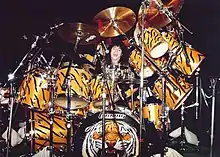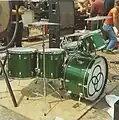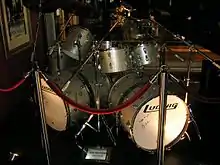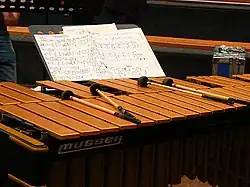Ludwig Drums
Ludwig Drums is a United States musical instrument manufacturer, focused on percussion. It is a subsidiary of Conn-Selmer.
 | |
| Formerly | Ludwig & Ludwig Leedy & Ludwig WFL Drum Company |
|---|---|
| Type | Subsidiary |
| Industry | Musical instruments |
| Founded | December 11, 1909 in Chicago, Illinois, United States |
| Founder | William F. & Theobald Ludwig |
| Headquarters | Monroe, North Carolina, United States |
| Parent | Conn-Selmer |
| Subsidiaries | Musser Mallet Company |
| Website | ludwig-drums |

Products manufactured by Ludwig include timpani, drum kits, and drum hardware. The company also makes keyboard percussion instruments, such as marimbas, vibraphones, and xylophones, through the Ludwig-Musser brand.[1]
History
The Ludwig Drum Company was established in 1909 by William F. & Theobald Ludwig, sons of a German immigrant to the United States.[2] William Jr. had been a professional drummer, playing with circuses and touring vaudeville shows, along with the occasional skating-rink gig. Since this work was irregular, he and his brother, Theobald, opened a drum shop in Chicago; they called it Ludwig & Ludwig.[3] The company started with a concept for the design and manufacture of a functional bass drum pedal.[4]
The company added new products to its catalog, such as snare drums and timpani, in 1916. In 1917, Ludwig signed a deal to build rope-tensioned snare drums to support World War I. Theobald Ludwig died in 1918, and William continued on his own.[4][3]
In the late 1920s, the company was sold to the C.G. Conn instrument company. William Ludwig stayed on to run the company for Conn (which also owned the Leedy Manufacturing Company at this time). Eventually, William Ludwig decided to leave Conn and start a new company of his own. He was unable to use the Ludwig name since that trademark now belonged to Conn who continued to market Ludwig & Ludwig drums.
%252C_American_Banjo_Museum.jpg.webp)
_at_American_Banjo_Museum.jpg.webp)
_at_American_Banjo_Museum.jpg.webp)
In 1937, William bought a factory building and started The WFL Drum Company (his initials). The company continued producing drums at a small scale for the duration of World War II, but William got back to the idea of making the company a large drum manufacturer after the war ended. WFL was a competitor with Ludwig and Ludwig. Conn combined their two drum brands into one in the early 1950s, forming Leedy & Ludwig, and then decided to quit the drum business altogether. In 1955, William and his son Bill Jr. were able to buy the Ludwig trademark back from Conn, and over the next few years their company and its products transitioned from the WFL brand to being called "Ludwig" again.
Despite initial success, Ludwig's global breakthrough would occur February 9, 1964, when The Beatles made their historic American TV debut on The Ed Sullivan Show.[6][7] The Ludwig logo, displayed on the front of Ringo Starr's bass drum, could be seen by the television audience of about seventy-three million people.[8][3][7] As it happens, Starr chose that brand upon joining the band simply because he liked the oyster pearl black color of the drum kit he chose.
[Ringo Starr] put our name on the front of his bass drum head ... [because] he was so proud that he had an imported drum set from America, especially from a famous company like Ludwig, that at the time of purchase he insisted on having the Ludwig name painted on the front of the head!
— William Ludwig's grandson[3]
The publicity resulted in Ludwig's sales doubling quickly to $13 million, which prompted production to increase to a 24/7 production as the company became the foremost drum manufacturer in North America for twenty years.[9]
Ludwig acquired the Musser Mallet Company, a manufacturer of xylophones, marimbas and vibraphones, in 1965.[2] Ludwig was a strong presence in the marching drum market. During the 1970s, Ludwig's "Challenger" line of snare drums offered sophisticated tuning and strong build quality. Ludwig drums were used by many leading drum and bugle corps.
On 4 November 1981, William F Ludwig II sold the business to the Selmer Company (now Conn-Selmer). Selmer closed the Damen Avenue factory in the ensuing years and moved the drum production business to Monroe, North Carolina, in 1984.[2][3][10] In 2002, Ludwig merged with Conn-Selmer, becoming a brand of Conn-Selmer, Inc.[11]
The Musser manufacturing facility remained in LaGrange, Illinois, until 2013, and was then moved to Elkhart, Indiana.[12]
Gallery
 1918 Ludwig drum set.
1918 Ludwig drum set. Ludwig drum set, in Black Oyster Pearl, used by Ringo Starr with The Beatles.
Ludwig drum set, in Black Oyster Pearl, used by Ringo Starr with The Beatles. Ludwig Vistalite drum set.
Ludwig Vistalite drum set. Ludwig Vistalite drum set in Amber.
Ludwig Vistalite drum set in Amber.
 Five-piece Ludwig drum set, in Green Sparkle, as used by John Bonham of Led Zeppelin.
Five-piece Ludwig drum set, in Green Sparkle, as used by John Bonham of Led Zeppelin. Ludwig drum set used by Alex Van Halen.
Ludwig drum set used by Alex Van Halen. Musser vibraphone
Musser vibraphone Ludwig timpani
Ludwig timpani
References
- "Ludwig-Musser". Conn-Selmer, Inc. Retrieved March 16, 2022.
- "Ludwig". Our Brands. Conn-Selmer, Inc. Archived from the original on August 27, 2016. Retrieved December 21, 2015.
- Ludwig, Jerome (May 7, 2012). "The origins of Ludwig drums". Chicago Reader. Retrieved November 13, 2022.
- "Ludwig on Conn-Selmer website". Archived from the original on November 20, 2014. Retrieved November 13, 2014.
- "Makers Alphabetically". vintagebanjomaker.com. Retrieved March 13, 2020.
- "The Beatles on The Ed Sullivan Show on February 9, 1964" on Ed Sullivan website
- "The Beatles’ first Ed Sullivan Show" on The Beatles Bible
- "The 1960s" at Vintage Ludwig Drums
- O'Reilly, Terry. "Bookmarks 2016". Under the Influence. CBC News. Retrieved August 27, 2016.
- Selmer's History, 7 Dec 2011
- About: 2000-2009 on Ludwig website
- "Musser". Our Brands. Conn-Selmer. Archived from the original on October 5, 2017. Retrieved December 21, 2015.
External links
- Official website

- William F Ludwig II Interview at NAMM Oral History Library (2002)
- William F. Ludwig III Interview at NAMM Oral History Library (2009)